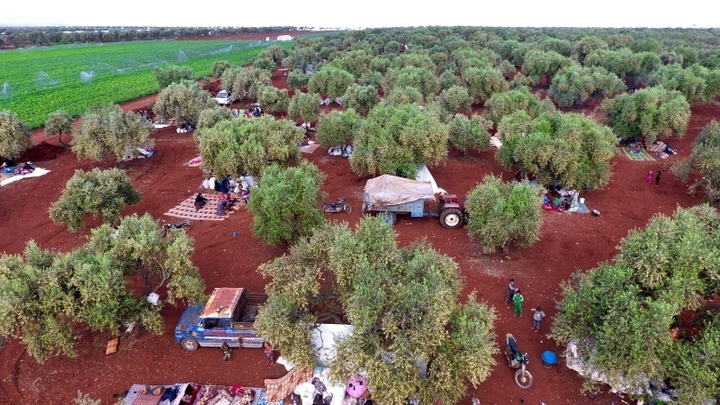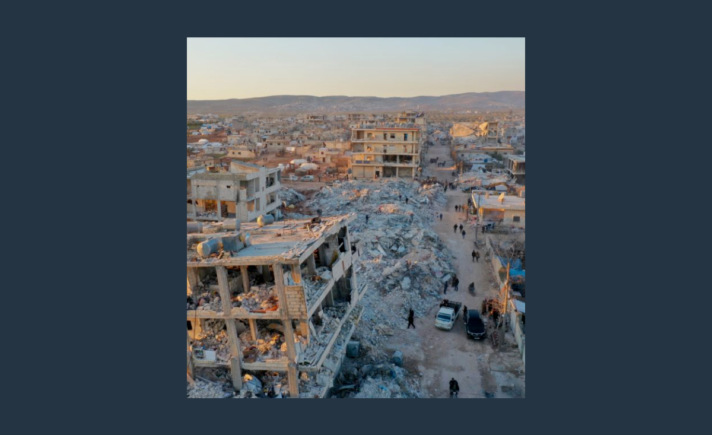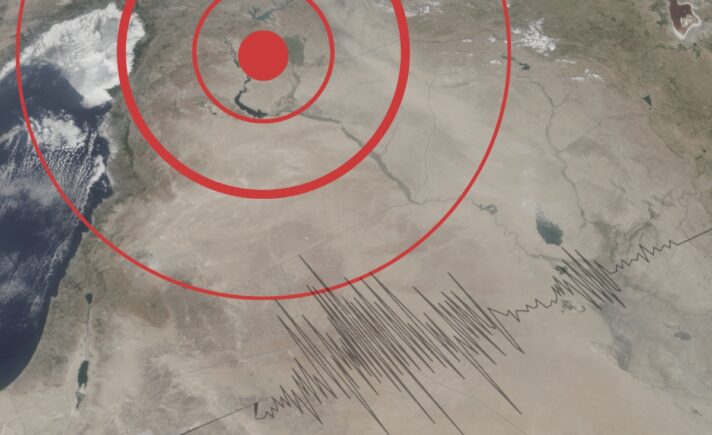The bombing campaign waged in northern Syria by the Assad regime and its Russian and Iranian allies between late April and 18 August of this year has brought about the displacement of some 576,000 people, half of them children, across various opposition-held areas, according to data published by the UN’s Office for the Coordination of Humanitarian Affairs (OCHA) last week.
The figure includes over 72,000 displaced in the course of the regime’s recapture of the strategic town of Khan Shaykhun and adjacent parts of northern Hama Province; that is, fighting that occurred within the first eighteen days of August alone. For its part, the Syrian Response Coordination Group said in a report issued 26 August that the number displaced within Idlib Province since October 2018 now stands at over one million.
In light of these dramatic numbers, it can be said that northern Syria currently faces the largest wave of collective displacement witnessed anywhere this century. Humanitarian organizations operating in the area say most of the camps that exist—whether official or ad hoc—are accommodating many multiples of their capacity; something which had already been the case before the latest displacement made matters worse still. These camps, some of which have been expanded by local governance councils in cooperation with international organizations, have been unable to contain, let alone reduce, the scale of the humanitarian catastrophe, especially given the continued bombardment and other military operations by the regime and its Russian partner targeting an ever-widening range of territory.
This exacerbation of internally displaced persons’ (IDPs’) misery coincides with the failure of the UN’s Humanitarian Response Plan (HRP) to secure the funding necessary to adequately carry out its work. The Syria Cross-border Humanitarian Fund (SCHF), established by the UN in 2014, had allocated $22.5 million for this response, and requested $29 million to carry out 45 projects by 33 partner organizations working in the region. As of 22 August, however, the plan had failed to raise more than 28% of the requisite funds, according to UN data.
43,000 cases of tropical disease in two months
Syrian humanitarian organizations working on the ground suffer from three main challenges, according to Hisham Dirani, co-founder of the BINAA Organization for Development.
“The first of these challenges is the displacement of large numbers of their personnel along with those displaced from Idlib and Hama Provinces, which has multiplied the burden,” Dirani told Al-Jumhuriya.
“The second challenge is the severe lack of funds, with donors and the UN covering just 10-15% of the extremely urgent needs. And the third challenge is the absence of shelter.”
On the ground, “the response of the UN has been very weak,” said Dirani. “There is insufficient funding, especially for the truly urgent needs of IDPs, such as shelter, clean water, and toilets, first and foremost. In the last allocation of emergency funding, there was not enough set aside for the provision of these needs; instead, the funding was reallocated to fuel, heating, and consumables.”
Dirani gives the following example to illustrate the inadequacy of the mechanism according to which the UN deals with the scale and nature of the humanitarian catastrophe in northern Syria.
“The UN distributed a few thousand tents to IDPs in recent months, without taking into consideration their needs for water, sanitation, and showers. The lack of these urgent necessities led to the recording of some 43,000 cases of leishmaniasis among those displaced within the past two months, due to the absence of showers and clean water.”
Dr. Mohamad Katoub, the head of advocacy in Turkey for the Syrian American Medical Society (SAMS), confirms that the most pressing needs in the current period are shelter and water, telling Al-Jumhuriya that “the response so far has been funded by humanitarian organizations’ own reserves, while the UN has only provided 9,000 tents, without allocating any monies for the basic needs of these tents’ inhabitants, like drinking water, household water, and sanitation.”
“Despite the fact the current wave of displacement in northern Syria is the largest since the war in Rwanda [1990-1994], it has nonetheless met with the weakest response, with the total emergency response allocations placed in the humanitarian support fund, by all donors combined, amounting to just $22.5 million for all sectors; health, shelter, water, sanitation, and food. That figure is the equivalent of what the UN allocated for the rehabilitation of a single hospital in the areas controlled by the Assad regime.”
According to the report published Monday by the Syrian Response Coordination Group, the essential, bare-minimum requirements needed to respond to this displacement crisis include over 51,000 tents; 121,369 food baskets; 78,698 non-food aid baskets; 98,742 drinking water tanks; 50 mobile clinics; 22,365 bathroom units; and a daily provision of 150,000 liters of drinking water and 202,365 packets of bread.
Paying to sleep under trees
As if the above weren’t enough, tens of thousands of IDPs have no access whatsoever to shelter, sleeping in the open air under the shade of olive trees, or inside their trucks. The reason for this is twofold, according to local sources. The first is the simple lack of space in any of the camps in northern Syria, and the attendant spike in house rental costs. The second is the absence of any available housing in the safer areas closer to the Turkish border. In certain regions, it’s impossible to find a single empty house, these sources told Al-Jumhuriya, adding that there are houses inhabited by two or even three families simultaneously.
As for the less safe areas, closer to regime-held territory—and particularly those close to and east of the Damascus-Aleppo highway—some of which face bombardment, and may become targets of future operations by the regime and its allies in the coming period, many IDPs prefer to stay away from them, fearing they will only be forced into displacement yet again before long. Others, however, have no choice but to turn to them to avoid sleeping out in the open, in which case they can find housing at lower rents, or no rent at all, in the event that locals open their doors to them for free as a gesture of solidarity.
Even in the open fields, however, many families are obliged to pay rent to landowners in exchange for permission to inhabit the shadows of their olive trees. In other cases, given the rise in rents—extending even to the olive groves in some instances—there is a degree of local solidarity offered, somewhat reducing the suffering of some families by offering them free or discounted accommodation, or securing them various forms of aid. Of course, these individual acts of solidarity, supported as they are by poorly-funded local entities, do not nearly suffice to face the gravity of the humanitarian disaster, which requires urgent international intervention to contain it, as the aforementioned figures published by the Response Coordination Group clearly demonstrate.
The sun will rise tomorrow on children in the open air in Idlib Province, and on villages and towns wiped from the face of the Earth by regime and Russian fighter jets, without any international reaction at the political level, or even at the humanitarian level. Faced with a crisis of displacement unprecedented in this century, the voices calling for an end to the continuous slaughter and annihilation taking place in broad daylight before the eyes of the world have all but disappeared entirely.
[Editor’s note: This article was originally published in Arabic on 26 August, 2019]







